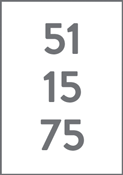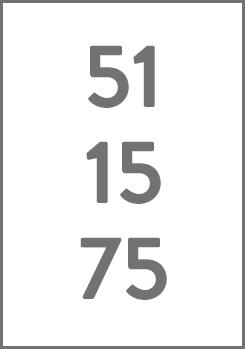
Everyone knows being talked at for 20 minutes is nothing short of boring. Challenger is about creating a conversation - that means both you and your target should be talking by the end! Drawing will help drive a conversation but these tactics below will help you grab attention.
Everyone knows being talked at for 20 minutes is nothing short of boring. Challenger is about creating a conversation - that means both you and your target should be talking by the end! Drawing will help drive a conversation but these tactics below will help you grab attention.
Remember when picking your technique, first think of the point you want to make, then pick the grabber that will do it best.
Number Play


Start things off provocatively and write down 3 numbers, ask the audience if they know what they mean. From here, start labeling the numbers to explain the points you want to make.
Here's an example: 51, 1 5, 75. What are they?
51% of forecasted initiatives fail to meet the company’s financial objectives, only 15% of CPG products are still in market in Year 2, initiatives tested with FFS are 75% more likely to succeed in market.
Go to Google+ and search for the “NLSN Innovation Challenger Group” to share your successful number play examples. Already a member? Click here.
A Good Ol' Story
Did you know that 65% of daily communication is stories and rumors? It makes sense then that a well told story (that connects to the point you’re trying to make) will connect with your audience. Stories come in two flavors:
CUSTOMER STORIES WITH CONTRAST
Think of how all weight loss product/gyms/programs show the before AND after - If you just showed the after, people wouldn’t think it was achievable. Just use the simple framework below to create contrast:
- Before working with us, one of our clients...
- Now that they're working with us,...
- Which means the client was...
PERSONAL STORY
A personal story is more like a simile or metaphor -- you take an experience in your life (NOT WORK) and show how the outcome in that relates to the point you’re trying to make. Here's a great example from Eric Donner.
Point being made:
You may have a favorite vendor, but you might be missing out and not even know it. Adding Nielsen to your arsenal to equip yourself no matter what question you have.
The story:
- At Nielsen we strive to have strong partner relationships. And many times when you work with a single vendor there’s a lot of benefits: they have that continuous knowledge base, you can get value pricing and overall ease of use because you’re used to working with them. So there are a lot of benefits to working with a single vendor, but there is a story I’d like to share with you to illustrate why adding us to your system might work well.
- I do a lot of business travel - in fact I go into Manhattan quite a bit. And what I try to do is multiple meetings on the same day so I minimize the IN and OUT to the city. And in order to get up town and down I can use one of two methods: a taxi or the subway… That is until it rains. And when it rains all bets are off. If you’ve been in Manhattan on a rainy day for a business trip you know what I’m talking about. So I can get soaked wait for a cab that will probably never show up or I can try to fight my way through the subway and end up looking like a steamy rat in a rumbled suit. Oh and I’ll probably be running late to my meeting.
- There was one day recently that I was in Manhattan and it was raining and I thought ‘Is there something else I could be doing that would help me?’. There’s a technology that came out called Uber. Now I’ve been resistant to get it for various reasons but on this day I had 3 meetings, I needed to get downtown quickly and I was stuck. So I downloaded the app, got into a car immediately, I stayed dry and got to my meeting on time. So by adding in this additional mode of transportation I was able to get through a day that I’d normally be struggling with. And in fact, Uber was so great, I’m even using it now on days that aren’t rainy. It was really that valuable to me.
- Recently we were working with a client similar to you and they had a very strong relationship with their vendor but we were able to run a parallel study with them on research they do quite often. What they found out is that we were able to pull out so many incremental insights from our study that they realized they had been missing out by only working with their incumbent. So we feel that by giving us a shot, we’ll be able to give you the same kind of results.
Share your successful stories on the Google+ Challenger page.
Props – yes, props
Now props might seem scary, but a well rehearsed prop can be a game changer (see the example). A prop should also have a deeper meaning exemplifying an idea or concept. Here's an example from Mike Rotolo:
Point being made:
When it comes to crafting the best concept, you’re not looking at all the options - or even worse, you’re making blind guesses. Nielsen Optimizer lets you evaluate all the options and find the winning combination.
The prop:
Another way to think of what you’re currently doing is like this [TAKE OUT DECK OF CARDS]. You have all these options for how to talk about your proposition [SHUFFLE THROUGH CARDS] but due to time, budget or research methodology constraints, you can’t evaluate at all of them [CUT DECK IN HALF]. So you pick what you think is right. Would you pick 5 cards for me [OFFER DECK FACE DOWN, HAVE THEM PICK 5 CARDS]. What hand did you get? Now with Nielsen Optimizer you can evaluate all of your options [PICK UP DISCARDED CARDS] and rely on consumers to identify which are best [TURN DECK OVER AND PICK A WINNING HAND] so that you identify the best concept, every time [REVEAL WINNING HAND]. So which would you rather have, your hand or mine?
Share your successful stories on the Google+ Challenger page.
Words in Common
Much like number play, you can use words in common. To do this write 3 words and as your audience to tell you what they have in common. Perhaps they don’t see it or perhaps there is something obvious that they point to: the goal is to point out the deeper level commonality that will illustrate your point. Here's an example from Kate James:
The words:
Wayz, A Sherpa, Fidelity Financial
The point / deeper meaning:
All of these things help you best navigate when there are many options you could take. Much like these Nielsen Optimizer helps identify the best concept to move forward.
Share your successful stories on the Google+ Challenger page.
Ask "What if you could..."
It’s a simple phrase but it’s the phrase that cues a brain to listen. You’ll see that all of our Why Us messaging uses this phrase - don’t skip it! It’s also the phrase that opens up the conversation. Remember we don’t want to lecture - we want to open the floor for a conversation that will help identify opportunities.
Copyright © 2016 The Nielsen Company. All Rights Reserved.





